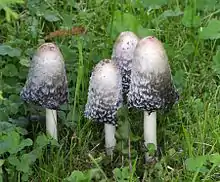
The edible shaggy inkcap

The conditionally edible common inkcap
Inkcap may refer to any of a number of toadstools of the genera Coprinus, Coprinellus and Coprinopsis.
The best known, and very good to eat:
- Coprinus comatus, the shaggy inkcap, lawyer's wig, or shaggy mane.
The next best known, and also conditionally edible:
- Coprinopsis atramentaria, the common inkcap, inky cap, or tippler's bane. Edible, but causes effects similar to those of disulfiram. As such, alcohol is to be avoided before,[1] during and after consumption.
Also any of the following, many of which are poisonous:
- genus Coprinus:
- C. alopecius, the distinguished inkcap
- C. sterquilinus, the midden inkcap
- genus Coprinellus:
- C. disseminatus, the fairy inkcap, fairies' bonnets, or trooping crumble cap
- C. domesticus, the firerug inkcap
- C. micaceus, the glistening inkcap, mica cap, or shiny cap
- genus Coprinopsis:
- C. acuminata, the humpback inkcap
- C. ammophilae, the dune inkcap
- C. episcopalis, the mitre inkcap
- C. jonesii, the bonfire inkcap
- C. lagopus, the hare's foot inkcap or harefoot mushroom
- C. nivea, the snowy inkcap
- C. picacea, the magpie inkcap or magpie fungus
- C. scobicola, the sawdust inkcap
- C. stangliana, the pied inkcap
References
- ↑ "Disulfiram Official FDA information, side effects and uses". Retrieved 2011-04-11.
This article is issued from Wikipedia. The text is licensed under Creative Commons - Attribution - Sharealike. Additional terms may apply for the media files.